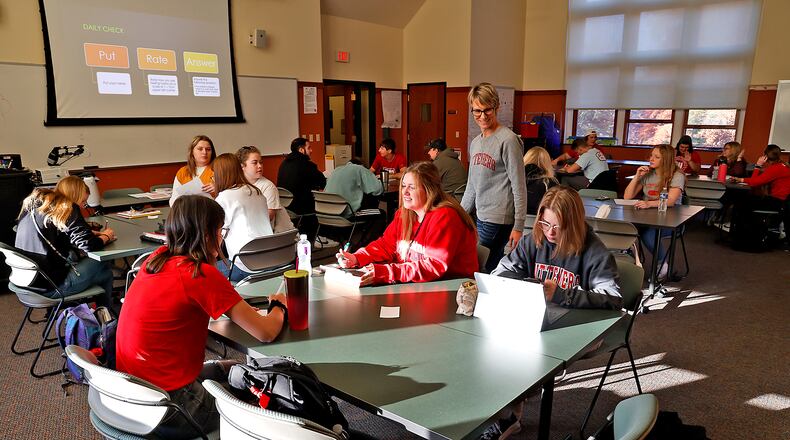Total undergraduate and graduate enrollment combined also declined 1.1% over last fall. The total rate of decline has slowed by almost half since last year when it dropped 2.1% and about a third since fall 2020′s 3.4% loss.
Experts are concerned because enrollment rates are still falling two years later, especially in freshmen, and can affect college careers and the workforce.
“After two straight years of historically large losses, it is particularly troubling that numbers are still falling, especially among freshmen,” said Doug Shapiro, executive director, National Student Clearinghouse Research Center. “Although the decline has slowed and there are some bright spots, a path back to pre-pandemic enrollment levels is growing further out of reach.”
Declines in undergraduate enrollment this fall are happening across all schools, especially among four-year institutions with a drop of 1.6% at public four-years, 0.9% at private nonprofits, and 2.5% at private for-profits, according to the Clearinghouse.
Wittenberg’s undergraduate enrollment declined by 28 students this year compared to last year, with 1,258 and 1,286 students, respectively.
Maribeth Stevens, vice president for enrollment management, said the landscape for higher education in the U.S. is challenging now with the “ongoing impact of the pandemic.”
Institutions that use “intentional and data-driven enrollment efforts” will meet the challenges,” she said.
Stevens said institutions need to also develop a strategic plan to help re-engage students who dropped out of school.
“The number of students who have dropped out of college has dramatically increased throughout the pandemic, and it is critically important for colleges and universities to develop strategic plans around re-engaging these students,” she said. “This is a generation of students that are at risk of never returning to the classroom, ultimately losing out on the proven long-term benefits of a college degree.”
Enrollment declines at community colleges also slowed down, with only a 0.4% loss.
Clark State has declined by 347 students this year compared to last year, with a total of 4,785 this fall so far and 5,132 last fall.
Although enrollment has declined, Dawayne Kirkman, vice president of student affairs, said the college is still in the position to continue to serve its communities with their “strong foundation and future-focused vision.”
The college has used programs the past three years to help onboard “all of our students through a culture of care to increase a greater sense of belonging,” he said.
If enrollment continues to decline each year, Kirkman said the state and community will have fewer students prepared for higher-paying and higher-skilled jobs that are in demand.
“Enrollment and community college is often cyclical and dependent on regional demographics. Our potential students may be choosing work in the short-term over education, though this decision stalls their career advancement,” Clark State President Jo Alice Blondin said.
The Clearinghouse data showed freshmen enrollment also declined in higher education, except community colleges, which saw a slight increase.
Total freshmen enrollment declined by 1.5%, dropping in all four-year sectors at 3.1% at private nonprofits, 2.4% at public and 0.9% at private for-profits.
However, at Wittenberg, first-year enrollment increased by 47 students, with 405 this fall compared to 358 last fall.
Stevens said the increase is a result of recruitment efforts and a “true testament to the student-first experience and mentality of the institution as a whole.”
“Students and families are increasingly conscious of affordability in the college search process, and it is important for institutions to be able to effectively communicate the value of the student’s degree,” she said. “Internships, experiential learning opportunities and career placement rates are important aspects for enrollment teams to be able to articulate, while the prospect of joining the job market might often be more attractive to students in the short-term.”
Freshmen enrollment at community colleges seems to have stabilized for the first time since the pandemic, according to the Clearinghouse. Community colleges had a 0.9% increase, driving an upward trend of 1% freshmen growth since fall 2020.
Clark State gained six freshmen students as enrollment was 1,162 this fall and 1,156 last fall.
Blondin said the college has had positive new numbers in summer 2021 to fall of this year, and they are also up slightly for fall 2022.
“We will need more support from the communities we serve with getting the word out about affordability and the quality of a community college education,” she said.
The Clearinghouse data shows the slower decline of community college enrollment is driven by an 11.5% increase in dual-enrolled high school students.However, local college numbers showed a decrease in dual-enrolled students.
Clark State had a 127 student decrease in dual-enrolled students at 1,529 this fall compared to 1,656 last fall. Wittenberg also showed a decline at 17 this fall compared to 22 last fall.
About the Author

